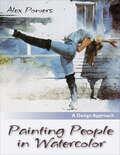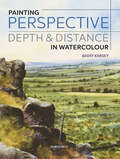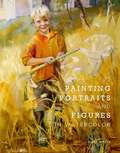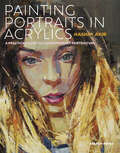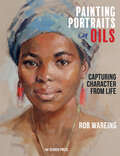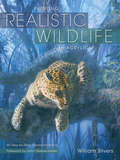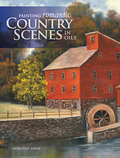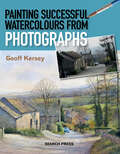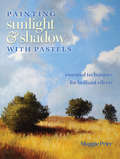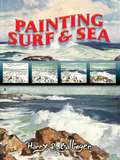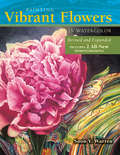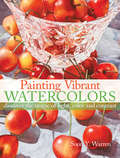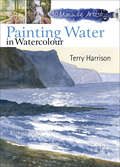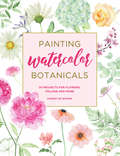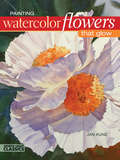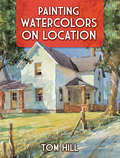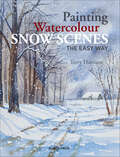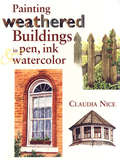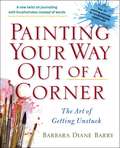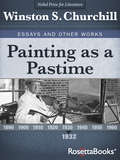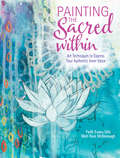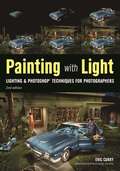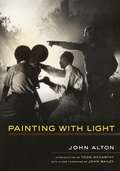- Table View
- List View
Painting People in Watercolor: A Design Approach
by Alex PowersA fresh approach to portrait and figure painting in watercolor! In Painting People in Watercolor, Alex Powers provides a comprehensive guide on working with watercolor, mastering the principals of design, and understanding the fundamentals of portrait painting. Powers takes the inquiring artist beyond photorealistic painting and acquaints painters with the human form from a design perspective. Shifting the focus from subject matter to composition and aesthetics, Powers demonstrates how you can enjoy watercolor painting by expressively capturing character in faces and figures. An abundance of Powers's paintings illustrate the theories and techniques covered. The culmination of 23 years of Powers's painting experience, Painting People in Watercolor provides clarity and insight on successful watercolor painting techniques for novice to advanced students and doubles as a guide for teachers. 175 color plates; 100 black & white illustrations.
Painting Perspective, Depth & Distance in Watercolour: Depth And Distance (Watercolour Painting Tips And Techniques Ser.)
by Geoff KerseyThe master watercolourist shares essential techniques for adding depth and realism to your watercolour paintings in this accessible guide.In Perspective Depth and Distance, watercolourist and teacher Geoff Kersey demonstrates how to use line, tone, colour, and detail to create captivating landscapes. With this practical guide, you will learn to capture the beauty of mist-draped mountains and dense woodlands. You will also learn to paint boats, buildings, and natural features that seem to recede into the distance. This volume includes seven step-by-step projects with inspiration and ideas for your own original landscapes. It also features techniques for linear and aerial perspective.
Painting Portraits and Figures in Watercolor
by Mary WhyteDesigned to address beginning to intermediate artists, this book is the ultimate guide to portraiture and figure painting in watercolour. It guides artists through the entire portrait and figure painting process, from selecting the right materials and tools to exhibiting the finished painting. Richly illustrated, the book features paintings by such masters of watercolour as Winslow Homer, John Singer Sargent and Georgia O'Keeffe.
Painting Portraits in Acrylics: A Practical Guide to Contemporary Portraiture
by Hashim AkibAward-winning artist Hashim Akib's striking portraits are at the heart of this inspirational book. The subject of portraiture is seen by many as the zenith of art, and Hash's easygoing, unpretentious style puts fantastic results within the reach of hobby artists and aspiring professionals alike.Assuming nothing and starting from the basics – making it suitable even for the enthusiastic beginner – this book includes six step-by-step projects to follow; along with friendly but in-depth advice on colour palettes; skintone; composition; working from photographs and models; markmaking; lighting; atmosphere and much more.The book covers many types of portraiture – from the self-portrait to full-length portraits – all presented in Hash's striking, free and contemporary style.
Painting Portraits in Oils
by Rob WareingRob Wareing has built a formidable international reputation as a portrait artist. This is his first book, and here he draws on over 40 years' experience to provide a complete guide to painting portraits in oils.In Rob's view, the most effective way to capture character is by working from life rather than photographs, and to follow the alla prima method to create a painting in one sitting.Starting with a fascinating overview of the subject, Rob then guides the reader through the materials he uses, explains how to pose and light the sitter, and how to prepare the work area before starting to paint.This is followed by detailed coverage of design and composition, the importance of proportions, and the painting process itself – from colour mixing through to finishing a painting without over-working. With clear, step-by-step demonstrations and numerous examples of the author's work throughout, this book provides both an expert guide to portrait painting and a unique insight into the working methods of one of the world's leading portrait painters.
Painting Realistic Wildlife in Acrylic: 30 Step-By-Step Demonstrations
by William SilversA Master Artist Shares His Straightforward Approach for Capturing the Essence of NatureOne measure of a painting's success is the emotion it elicits from its viewer; William Silvers' wildlife scenes make your pulse quicken and your breath catch as you witness some of nature's most miraculous everyday moments. The midnight prowl of a wolf...a sea lion diving into choppy surf...a pride of elephants at a watering hole in the thick, dusty air. In this book, Silvers shares his secrets for capturing the drama, the atmosphere and the very essence of wildlife.Accessible "whole painting" approach using limited materials and multiple acrylic washes15 mini-demonstrations illustrate key acrylic techniques and how to use them to best effect15 complete step-by-step demonstrations feature a stunning range of animals, including golden eagles, swans, wolves, foxes, giraffes, deer, elk, black bears, polar bears, alligators and various big catsFull of rich colors, a gripping sense of life and masterful advice for achieving the same, this book will help intermediate artists and advanced beginners achieve new levels of success and expression.
Painting Romantic Country Scenes in Oils
by Dorothy DentPaint the charm of country scenesThese tranquil scenes let you create your very own painter's retreat with a luminous sunset, a quiet cottage, a refreshing coastline and peaceful streams meandering past mills. It's easy and fun when you paint along with Dorothy Dent.With 10 step-by-step projects, suitable for both beginners and more accomplished painters, Dorothy shares her easy-to-follow techniques for painting realistic landscapes. Learn how to paint:Rich autumn foliageThe vivid greens of springColorful reflections found in still waterGlowing light from a window on a starry nightSnow-capped mountains created with a palette knifeYou'll also learn valuable principles such as consistent highlights and shadows, how to contrast lights and darks and how to use textures, colors and values. Dorothy shows you exactly how to hold the brush and position the bristles against the canvas so you can make confident brushstrokes. Each painting also features a special Seeing with the Artist's Eye section that teaches you the artistic principles that take a painting from average to extraordinary.
Painting Successful Watercolours from Photographs
by Geoff KerseyLearn the essential techniques for painting from photographs with this illustrated guide by the acclaimed artist and teacher.Many artists enjoy using photographic reference material, but while there are many advantages to this way of working, there are also unique challenges. One must learn to choose what to leave out, what to keep in, and how to adapt the scene to create a painting. In this book, Geoff Kersey introduces twenty-seven of his own paintings, explaining how they evolved from one or more photographs.Kersey includes photographs, sketches, diagrams, details, colour charts and a wealth of tips explaining his techniques and artistic process. This volume also includes a glossary of painting terms as well as photographs for readers to interpret for themselves.
Painting Sunlight and Shadow with Pastels: Essential Techniques for Brilliant Effects
by Maggie PriceInfuse your paintings with light and life! Whether you work outdoors or indoors, understanding the effects of light and shadow is key to making your art lifelike and engaging. Rather than providing a one-size-fits-all recipe for painting light, this book shows you how to capture the particular ambient qualities of any scene before you, be it a gloriously clear morning, a rainy afternoon, or the joyful dance of sunlight on water. Master pastel artist Maggie Price shares techniques for painting beautiful light, rich shadows and convincing reflections. 10 step-by-step demonstrations tackle a diversity of lighting situations, encompassing various weather conditions and times of day. Five contributing artists explore different styles, approaches and subjects, including landscapes, water scenes and people. Concepts are demonstrated with pastel but are applicable to any medium. An illuminating read for beginning and experienced artists alike, this book will help you engage your viewer by achieving that captivating sense of "being there."
Painting Surf and Sea
by Harry R. BallingerAn award-winning artist and teacher shows how to recapture the beauty and majesty of the sea in this simply written yet authoritative book. Seasoned artists and beginners alike will appreciate its profusely illustrated guidelines, which offer not only step-by-step instructions on depicting seascapes, but also many tips on picture-making in general.Artist Harry R. Ballinger shares insights from his decades of experience with marine painting, clearly explaining the principles on which the sea and surf operate. He combines the basics of composition and color mixing with easy methods for painting surf, sea, skies, sandy beaches, waves, and rocky shores. He also offers invaluable suggestions for choosing everything from the right brush and paint to the appropriate practice subjects. Twelve color and 85 black-and-white illustrations enhance the text.
Painting Vibrant Flowers in Watercolor: Revised & Expanded
by Soon Y. WarrenPaint flowers with feeling! You can paint watercolors that capture the beauty and personality of roses, peonies, zinnias and many more brilliant blooms--and achieve color more vivid than you ever dreamed possible with watercolor. In this expanded edition of Soon Y. Warren's best-selling book, she will help you: Capture the unique shapes, textures, details--and temperaments--of magnolias, hibiscus, sunflowers, bougainvillea, gladiolus, dahlias, water lilies and more. Use watercolor to duplicate and enhance the floral colors you see in nature, from subtle to saturated. Create dramatic compositions that excite your viewers. Complement your floral subjects with luscious surrounding textures (antique copper, smooth glass, rich fabric) and flattering backgrounds. Learn fun and easy techniques for underpainting, mingling and texturing with 23 step-by-step demonstrations. Don't be a shrinking violet--express yourself with bold watercolor florals that have as much personality as you do!
Painting Vibrant Watercolors: Discover the Magic of Light, Color and Contrast
by Soon Y. WarrenPaint Watercolors that Shine! Make the most of watercolor's fresh, vibrant nature through light, color and contrast. In the first few chapters, artist Soon Y. Warren helps you lay the groundwork - everything from choosing and lighting subjects to color theory and perspective. Then, follow along with a thrilling series of step-by-step demonstrations to put your ideas into action for paintings that shine!Learn how color, value, contrast and composition affect the impact of your paintingsDiscover the plans and techniques you'll need for successful, realistic watercolorsFollow 16 demonstrations to create brilliant paintingsPaint a variety of subjects, including still life, landscapes, water scenes, flowers, architecture and animalsThis book is the perfect balance of classic theory and hands-on technique. Engaging and easy-to-follow instruction gives you a solid foundation so you can take your work to the next level as you create dynamic paintings.
Painting Water in Watercolour (30 Minute Artist)
by Terry Harrison“From beach scenes to ponds, rivers to seas, puddles and streams, Terry shows how to paint water in all its beautiful painterly effects.” —Karen Platt, yarnsandfabrics.co.ukAll watercolour landscape artists need to know how to paint water, and in this book Terry Harrison excels in demystifying the painting process. Here he shares his expert advice and no-nonsense tips and techniques for producing quick, effective paintings of water. There are two or three-step exercises for painting water in all its varied moods and situations, including ripples, reflections, puddles, streams, breaking waves, choppy water, surf, bridges, riverbeds, boats, and much more. There are then ten step-by-step demonstrations that can be produced in half an hour: a misty lake, track with puddles, ford, waterfall, lazy river, stormy sea, cliffs, fisherman, sunset estuary and fishing boat.Essential painting skills conveyed through quick, lively studiesExpert art tuition from a renowned artist, for beginners, the busy artist, or those wanting to loosen up their painting styleNumerous quick exercises and ten step-by-step demonstrations in a handy, affordable ebook format“Terry demonstrates twenty-three basic exercises to build your confidence with the subject from rippled reflections to crashing waves, fast-flowing streams to sun setting on the sea.” —The Leisure Painter
Painting Watercolor Botanicals: 34 Projects For Flowers, Foliage And More
by Harriet de WintonLearn to create your own beautiful watercolor botanical art with more than 30 projects, as well as information on materials and basic techniques. The graceful, contemporary style of these flowers and foliage is attractive and accessible to all no matter your skill level.
Painting Watercolor Flowers That Glow
by Jan KunzA celebration of light Light has the power to make an ordinary flower extraordinary. Inside, Jan Kunz shares simple, step-by-step techniques for capturing that celebrated "glow" in watercolor. A classic approach to a timeless subject, this encore publication of Kunz's best-selling book covers a fabulous range of inspirations, from lilacs artfully arranged in a sterling vase to daisies skipping along a picket fence. Beautifully illustrated pages feature: * 20 special floral painting techniques * 6 paint-along demonstrations, complete with preliminary drawings * a comparison chart of 21 pigments and their special uses for the flower painter * coverage of everything from selecting materials and arranging flowers, to mixing glazes for radiant effects Kunz explains how composition, color theory and other important elements of painting apply to painting flowers, distilling years of experience into key techniques artists can take straight to their work for sparkling results. It's the perfect pick for artists who want to spend more time at the easel and less time reading about it. www.artistsnetwork.com Ideas. Instruction. Inspiration.
Painting Watercolors on Location
by Tom HillA comprehensive workshop approach presented by a master watercolorist, this guide features 11 step-by-step demonstrations filled with valuable methods and techniques for achieving striking on-site watercolor compositions. Beautiful examples and locations — including the Greek island of Santorini, a desert oasis, and a Midwest farmhouse — provide a wealth of inspiration as author and artist Tom Hill demonstrates how to paint intelligently, selectively edit a scene, and more.Painting Watercolors on Location shows developing artists not only how to acquire better understanding and techniques for painting on location but also how to incorporate these helpful practices into their everyday routines. Suitable for art students and artists at the intermediate level and up, these pointers include suggestions for choosing the correct on-site equipment, rendering accurate drawings, selecting and mixing colors, forming textures, and other methods for creating exciting and expressive watercolor paintings.
Painting Watercolour Snow Scenes the Easy Way
by Terry HarrisonSnow scenes are a popular subject of painters all year round. In this inspiring and accessible guide, best-selling author and popular tutor Terry Harrison shares a wealth of tips and techniques for painting snow in watercolour. Suitable for artists of all abilities, Terry shows you how to capture the beauty of snow-covered landscapes using easy techniques. The book begins with guidance on colour mixes and brushes for achieving different effects, and moves on to step-by-step demonstrations of painting snow-laden trees, frozen streams, wintry skies, falling snow, and the warm glow of a low winter sun. He provides valuable tips on using photographs for reference, and turning a summer landscape into a snow-covered one. There's also a section on how to create a traditional Christmas scene, and how to turn it into a Christmas card. With numerous examples of Terry's beautiful artwork, this book is a truly indispensable guide for anyone wishing to paint snow scenes in watercolour.
Painting Weathered Buildings in Pen, Ink & Watercolor
by Claudia NiceCapture the Beauty & Charm of Wonderful Weathered Buildings!Paint may fade and iron may rust, but the character of buildings strengthens with age. Join Claudia Nice as she shows you how to portray the mellow hues, weathered wood, cracked windowpanes and other imperfections that make old buildings perfectly wonderful subjects to paint.Using the exciting combination of pen, ink and watercolor, Claudia will help you discover the joy of painting barns, farmhouses, painted ladies, southern mansions and other beautiful classic buildings. Like a treasured artist's journal, this book is filled with art, inspiration and handwritten notes, along with Claudia's friendly, step-by-step instruction.
Painting Your Way Out of a Corner
by Barbara Diane BarryIn the tradition of The Artist’s Way , an exciting program that introduces painting as a jumping-off point for realizing one’s full creative potential in all areas of life. Based on author Barbara Diane Barry’s popular course Art for Self-Discovery and supported by research in psychology and the science of brain function, Painting Your Way Out of a Corner guides readers through the process of overcoming blocks and expressing themselves freely in painting. Through a series of exercises that emphasize improvisation and risk-taking, readers will learn how to quiet their inner critics and strengthen their creativity. The more we learn to play and accept whatever appears on the page, the more we are able to try new things in life. Readers will be inspired by Barry’s delightful full-color paintings featured throughout the book. .
Painting as a Pastime (Winston S. Churchill Essays and Other Works #1)
by Winston S. ChurchillThe first volume in a collection essays and journalism from the legendary politician and Nobel Prize–winning author explores his artistic pursuits. Legendary politician and military strategist Winston S. Churchill was a master not only of the battlefield, but of the page and the podium. Over the course of forty books and countless speeches, broadcasts, news items and more, he addressed a country at war and at peace, thrilling with victory but uneasy with its shifting role on the global stage. In 1953, he was awarded the Nobel Prize for Literature for &“his mastery of historical and biographical description as well as for brilliant oratory in defending exalted human values.&” During his lifetime, he enthralled readers and brought crowds roaring to their feet; in the years since his death, his skilled writing has inspired generations of eager history buffs. Best known for his political genius and keen eye for military tactics, Churchill was a man of many talents—not the least of which was painting. Throughout his life, Churchill painted to relieve his mind from the demands of leadership and to keep the &“black dog&” of depression at bay. Included in this volume are Churchill&’s meditations on painting as a salve for the spirit and an essential creative pursuit. His love for the craft comes to life in this concise yet impassioned work. This volume includes eighteen reprints of Churchill&’s original work in oil, giving the reader a window into the little-known creative and artistic skill of this prominent figure in twentieth century history.
Painting the Sacred Within: Art Techniques to Express Your Authentic Inner Voice
by Faith Evans-Sills Mati McdonoughClaim your space. Start painting. Begin now. By Painting the Sacred Within you, you'll unlock a new rhythm of working intuitively to allow space for your own transformation. Inside these pages, you'll discover twelve areas of focus as you learn to see your world through paint and to experience deeper self-exploration. You will learn new ways of seeing, how to experiment with abstract techniques, how to work with natural elements, how to meditate with mandalas and much, much more.Experiment with freeing and engaging techniques such as pouring paint, lettering with a brush and painting on unconventional surfaces.Uncover the continuous thread that runs through your work as you develop art-making rituals and learn the importance of investing time in your creative dreams as you develop healthy studio habits.In addition to more than 14 step-by-step demonstrations, you'll discover inspiring works from guest artists, learn helpful tips on self-care and find a plethora ideas for making creativity a part of your lifestyle.Begin a new practice today. Let Painting the Sacred Within ignite the creative spark inside you.
Painting with Light
by Eric CurryThrow your preconceptions about light-painting out the window and prepare for a creative journey that will revolutionize your photography. Light painting is a classic photography technique that involves selectively illuminating sections of a dark subject by moving a light source (like a flashlight) over the subject during the course of a seconds- or minutes-long exposure. This results in uniquely nuanced depictions with a high level of technical artistry. As Eric Curry shows, however, today’s hardware and software allow you to produce light-painting images that are anything but traditional! In this book, you’ll learn, step by step, how to plan and execute incredible, nuanced images using simple gear, a whole lot of imagination, and today’s powerful postproduction software. With these techniques, your imagination is the only limit to what you can create!
Painting with Light
by Janleonardo Woellert Joerg MiedzaLight Art Performance Photography (LAPP) is a unique form of art that was invented and developed by the authors of this book. It is one of the first forms of art using light as the medium to gain widespread attention. Unlike other types of light painting, LAPP does not just involve illuminating existing objects; it also requires the photographer to create and capture new subjects constructed entirely of light. LAPP pieces are usually shot at night using long exposure times to capture complex sequences of precisely choreographed movements. Real-world surroundings are combined with transient, light-based elements to produce spectacular effects. The defining characteristic of LAPP is the harmony between the background and the harsh light often used to produce the individual image elements. The symbiosis between photographer and performer gives each work a degree of reproducibility that is essential if it is to be accurately restaged at a later time. The first part of this book describes the evolution of LAPP as told by its originators, while the middle section goes on to present a gallery of spectacular, large format LAPP images. The final section offers some basic steps and tips to give you a starting point for creating your own LAPP artworks.
Painting with Light
by John AltonThis introduction to the workings of the Hollywood system provides a rich and accessible detail about special effects, technical wizardry and gadgetry, lighting, make-up, the breakdown of crews, and filming strategies.
